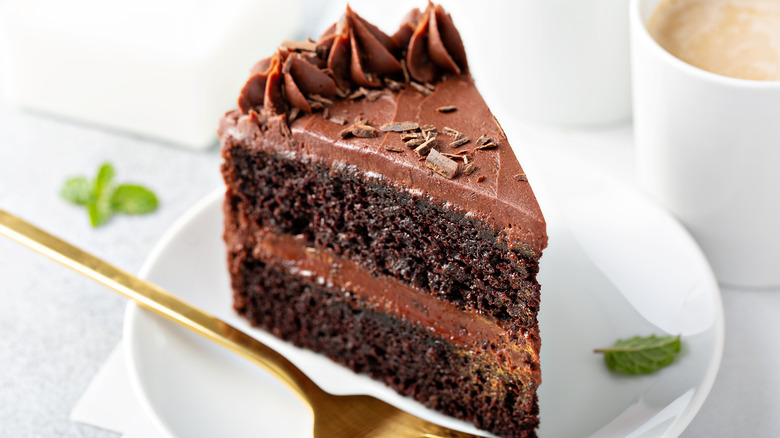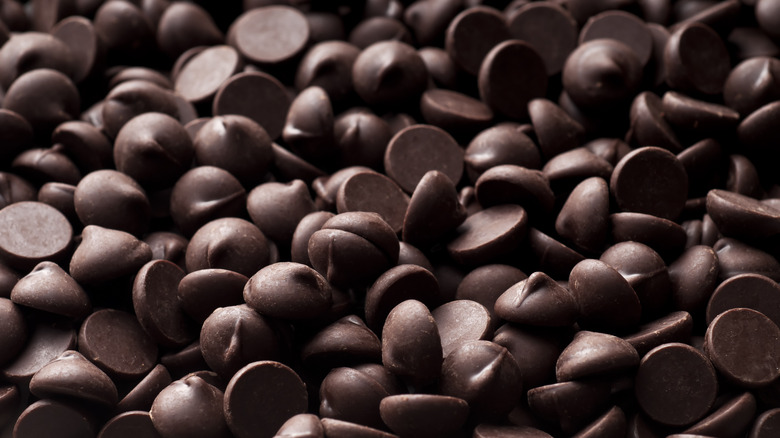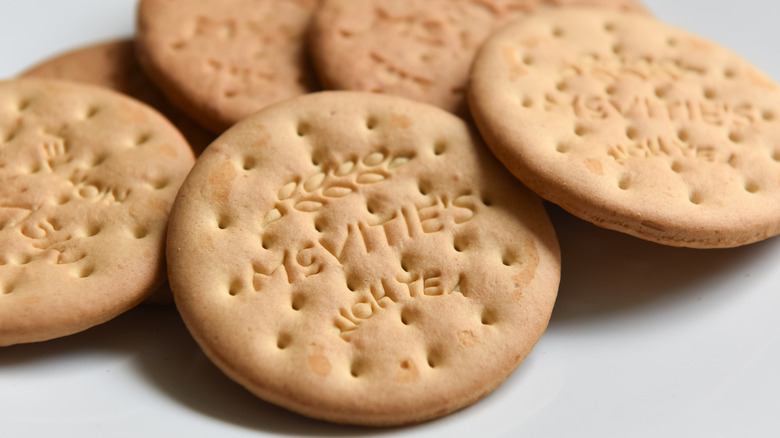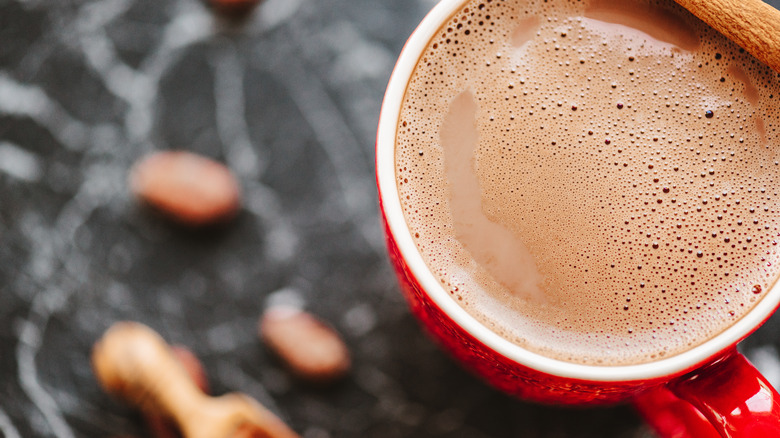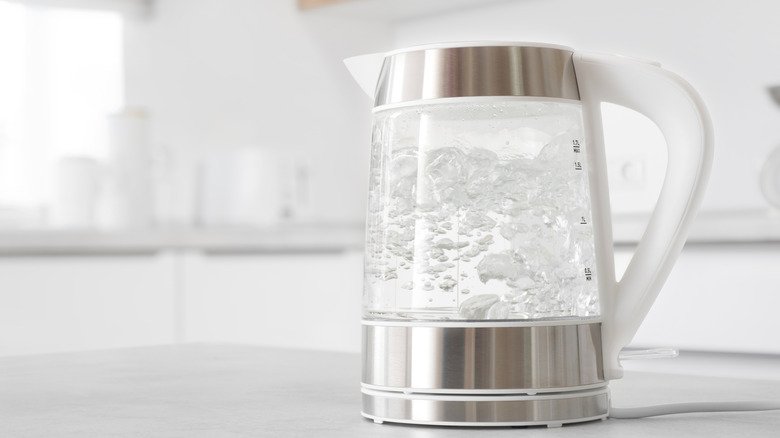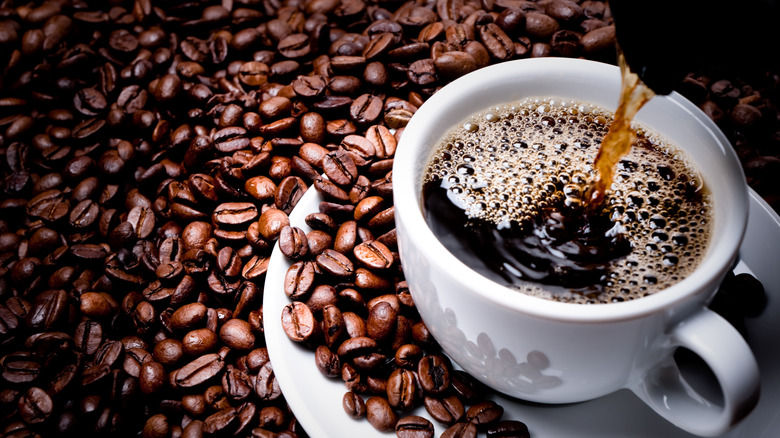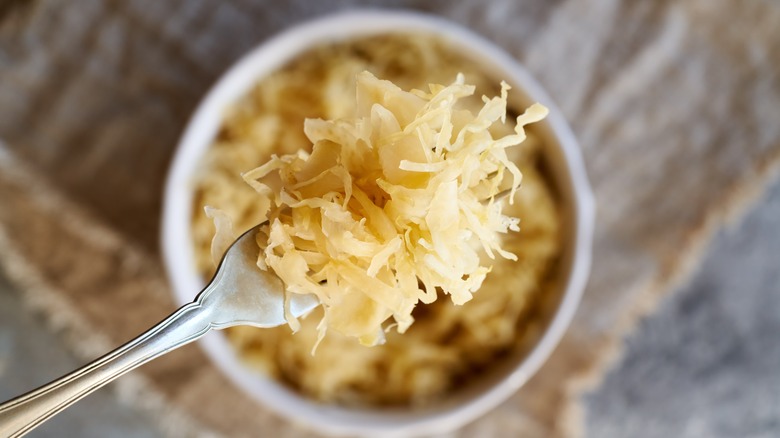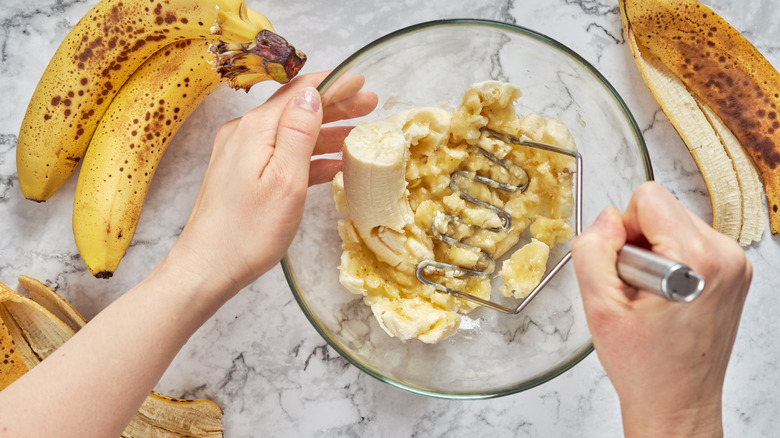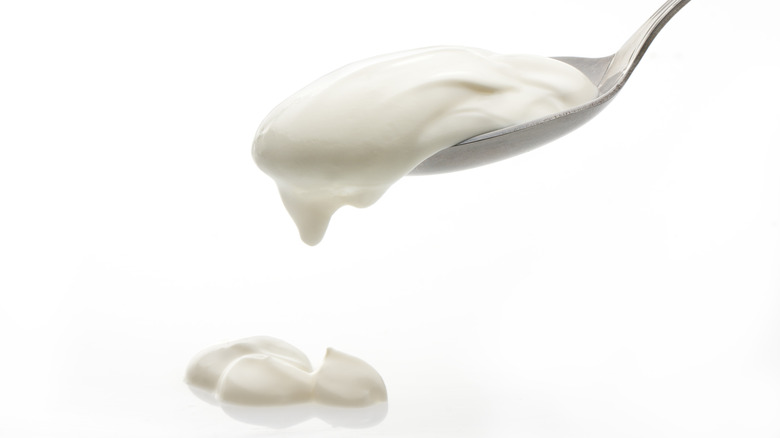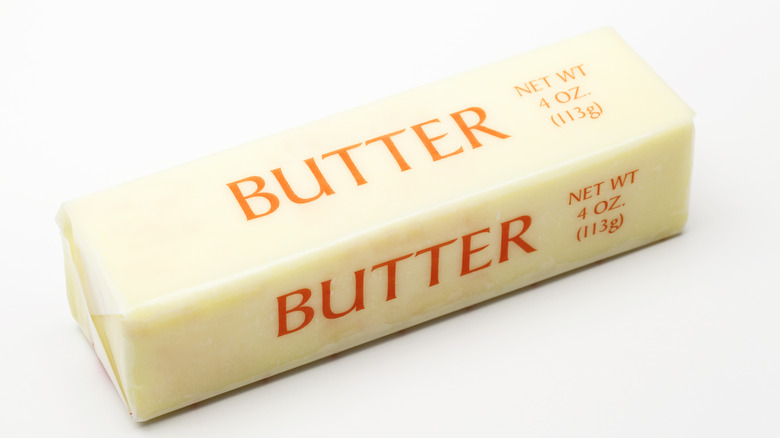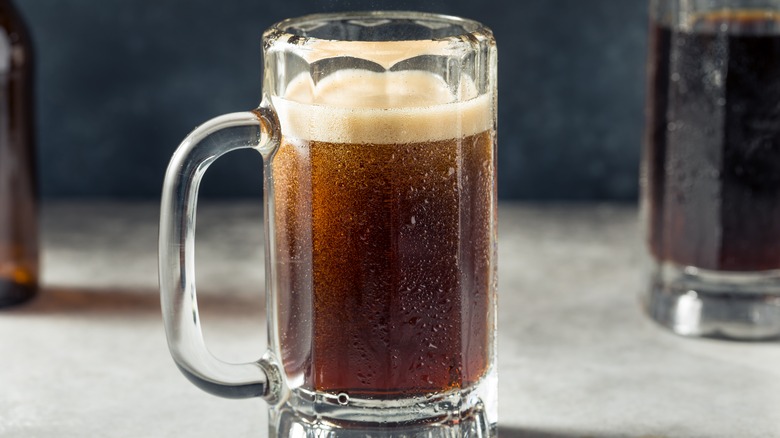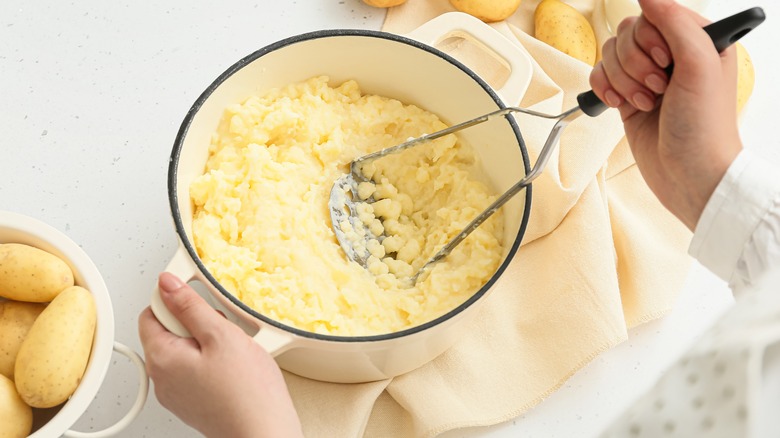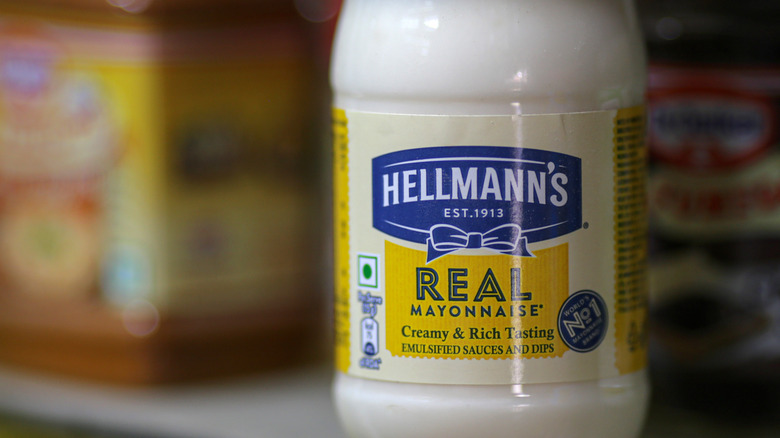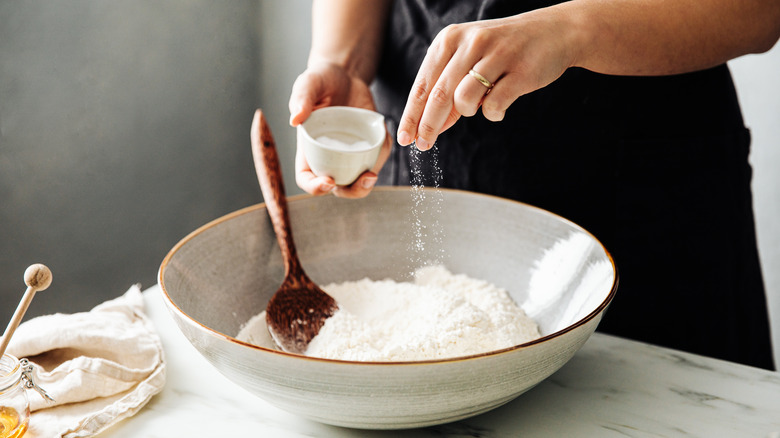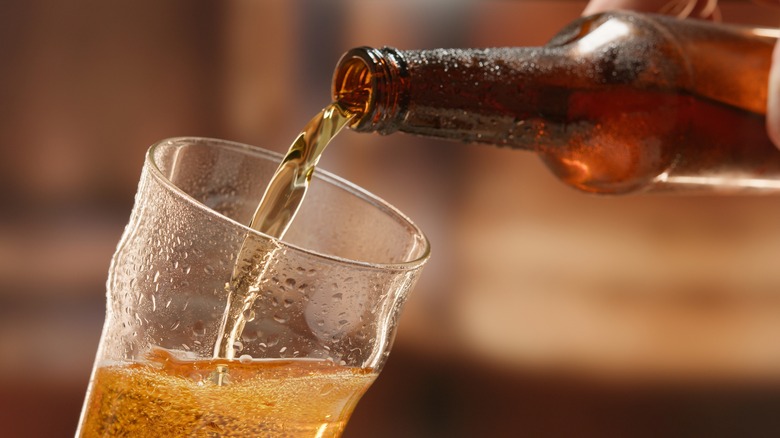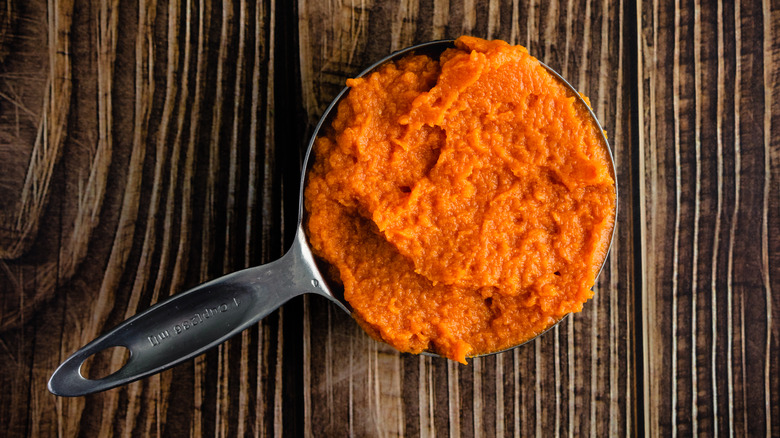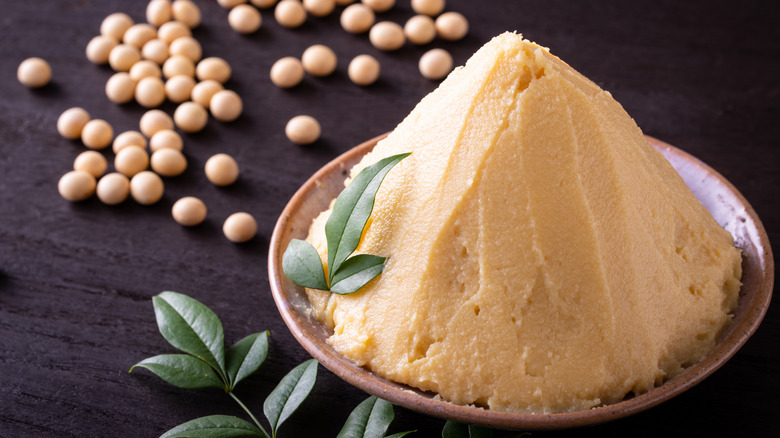16 Ingredients To Elevate Chocolate Cake
We think that every day is a fine day to enjoy chocolate cake. Moist, dark, decadent, fudgy — chocolate cake can make any day feel just a bit more special and celebratory. A delicious chocolate cake recipe is something every home cook has in their recipe collection. So, we're here to tell you that we've got some ideas for turning your rich, chocolaty cake recipe into something even better and more amazing. There are many ingredients that can be added to a chocolate cake to kick it up a notch and make it taste even better than what you're used to.
We're confident you'll be inspired by our suggestions, which include everything from mayo and miso to pumpkin and beer (yes, beer). So, read on to see which of our favorite ingredients to elevate chocolate cake you want to try. You may be familiar with some, while others may surprise you.
Chocolate chips
If you're a chocolate lover, adding chocolate chips to chocolate cake is a must. Melty bits of luscious chocolate add to the cake's delectability, making it taste even more divine. These days, you can find various types of chocolate in drop form — from milk or white to semi-sweet or dark. So, experiment and see which flavor of chocolate chip tickles your taste buds the most.
When adding chocolate chips to cake batter, it's wise to toss them with the dry ingredients first because the coating will prevent the chips from sinking to the bottom while baking. Another way to prevent unwanted sinking is to use mini chips instead of full-sized ones because there's less chance the lighter mini chips will sink to the bottom. If full-sized chocolate chips are all you have, try this nifty trick: Pour a thin layer of cake batter sans chocolate chips into the pan, then cover it with the remaining batter mixed with chips; the bottom layer will act as a barrier to sinking chips. Pro tip: Your chocolate cake may bake faster than usual when you add chocolate chips, so adjust your timer accordingly.
British tea biscuits
A staple of English tea time, rich tea biscuits are sweet, round cookies made with wheat flour, sugar, vegetable oil, and malt extract. These thin, light-colored biscuits have a wonderful trademark snap that goes great in a chocolate cake — and we can thank the British royal family for introducing us to this yummy combination.
According to Darren McGrady, the royal chef and former personal chef of Her Majesty Queen Elizabeth II, the former queen's favorite dessert was a chocolate biscuit cake. This unique cake is dense, chocolatey, and dotted with crumbled biscuits, so every bite features a pleasant crunch surrounded by rich chocolate flavor. Other members of the royal family were fans, too: Prince Williams celebrated his marriage to Catherine Middleton with a chocolate groom's cake studded with Rich tea biscuits.
Rich tea biscuits' plain flavor and crisp consistency make them the perfect addition to chocolate cake, upping its wow factor tenfold. To add them, simply crush the biscuits into bite-sized pieces and fold them into your cake batter. Not in the mood to bake? Leave your oven off and make a Tiffen instead, a Scottish no-bake chocolate biscuit cake.
Hot cocoa
Cocoa powder is an essential ingredient in many chocolate cakes. But sometimes, if used excessively, it can make the layers dry. Fortunately, there's a handy ingredient swap to add moisture back to the cake — and it can be done in minutes.
Simple syrup (water and sugar) could moisten dry chocolate cake layers. But we suggest using hot cocoa, essentially simple syrup plus cocoa powder. Drizzling (or brushing) your chocolate cake layers with hot cocoa will do the same moisturizing work as simple syrup while providing a boost of extra chocolate flavor.
You can always prepare hot cocoa from scratch, but since you're already spending energy and time making a cake, make your life a bit simpler by using a hot chocolate mix. First, stir up a serving, then let it cool to room temperature before pouring it into a squeeze bottle. Next, drizzle a generous amount over the cake layers to add moisture and flavor. Finally, frost and stack the layers, covering the entire cake with icing to lock in the moisture.
Hot water
If your chocolate cake recipe calls for cold or room-temperature water, consider replacing it with hot water. The hot water will "bloom" the cocoa in your cake more effectively than cold water via a reaction similar to when you brew coffee. When hot water mixes with cocoa powder, it draws out the chocolaty flavor from the cocoa, resulting in a cake with a more robust and pure chocolate flavor. If you want to create a cake with a deep, strong chocolate taste, swap out cold water and use hot water instead.
You may wonder if hot water should replace milk as well. Indeed, the fat in milk adds tenderness and flavor to cakes. But when milk mixes with chocolate, it tones down the pure taste of chocolate with its slightly sweet and sour taste. And when it comes to chocolate cake, we're after one thing — maximum chocolate flavor. So, opt for hot water, which is neutral and flavorless, to ensure the wonderful flavor of pure cocoa can shine through.
Coffee
Coffee is the one ingredient Ina Garten swears by to take a chocolate cake to the next level — and we wholeheartedly agree. Contrary to what you may think, adding coffee to chocolate cake batter won't make it taste like a mocha latte from Starbucks. Instead, coffee will deepen and sweeten the cocoa taste in your chocolate cake, making it more flavorsome. And depending on the type of chocolate you use in the recipe, coffee can amplify everything from floral or fruity notes to caramel or nutty aromas. When making chocolate cake, your goal should be maximizing the chocolate flavor, and coffee will help you.
To add coffee to your favorite chocolate cake recipe, substitute some or all of the liquid in the recipe with hot coffee (freshly brewed, please). If you don't have time to prepare a fresh brew, you can use espresso powder, concentrated instant coffee crystals that dissolve in liquid. Simply dissolve ½ to 1 teaspoon of espresso powder in the wet ingredients of your chocolate cake before blending in the dry ingredients.
Sauerkraut
This ingredient may seem to have come out of left field, but hear us out. Sauerkraut is salt-cured cabbage that is sour, salty, and wet. When added directly to chocolate cake batter, sauerkraut works in various ways to elevate the final product. The sour element in sauerkraut cuts back on the sweetness of the cake, while the salty notes enhance the chocolate flavor. Plus, the wet brininess of sauerkraut adds moist sponginess to the cake, preventing it from drying out. As it turns out, sauerkraut isn't just for hot dogs.
If you're wondering if you should rinse the sauerkraut before using it, the answer isn't so black and white. Store-bought sauerkraut is usually saltier than homemade versions. So, if you're trying to reduce your sodium intake or are concerned with making the cake taste overly salty, you should rinse the sauerkraut before stirring it into the cake batter. But you can skip the rinse if you aren't averse to salt or your sauerkraut doesn't taste that salty. Pro tip: If your sauerkraut has long strands of cabbage, chop them finely with a sharp knife to blend in better with the cake batter.
Bananas
There is a good chance you've got some ripe bananas on the counter just waiting to be used. And while smoothies and banana bread are the obvious go-to's for using them, consider mixing them into something more unique — like chocolate cake, where they can provide moisture and flavor while adding natural sweetness and health-enhancing vitamins and minerals.
Bananas contain about 75% water, according to the University of Cape Coast, making them an apt choice for adding moisture to cakes and all types of baked goods, including muffins, cookies, and brownies. Mixing a ripe, mashed banana directly into the batter for your chocolate cake increases the moisture levels. The result is a fudgy, moist chocolate cake with a tender texture. While the banana will likely introduce its trademark fruity flavor to the cake, you can curb this by increasing the amount of cocoa powder in the recipe or using a robust, high-quality cocoa powder.
Sour cream
If you want tender, moist chocolate cake every time, we've got a good 'ol standby that works wonders in baking: sour cream. This tangy dairy product is made by fermenting cream with lactic acid bacteria, which gives it a thick consistency and slightly sour taste. For optimal results, use regular sour cream in your cake instead of reduced fat because more fat means more richness, which translates to a luxurious, velvety texture.
Bakers often add sour cream to improve pound cake, so doing the same to chocolate cake makes sense. Sour cream, with its high-fat content, contributes richness and moisture to the cake while adding a subtle, nuanced tang that contrasts nicely with the sweetness of chocolate. The acidity of sour cream also works to tenderize the gluten strands in the cake, resulting in a soft, tender crumb. A final benefit to using sour cream is that it adds moisture without thinning out the batter, as a liquid (like buttermilk) or a wet ingredient (like mashed banana) would. So add a spoonful of sour cream to the chocolate cake batter, and your cake will turn out better. Period.
Butter
If you've ever analyzed various chocolate cake recipes, you may have noticed that some call for oil while others use butter. The recipes made with oil are likely traditional Devil's Food cakes, while the butter-based recipes are classic chocolate cakes. Both are delicious. But as we all know, the role of butter in baking is to add flavor and mouthfeel. So, if you want to up the wow factor of your chocolate cake, we suggest replacing some or all of the oil in your recipe with butter.
Aside from improved taste, there is another benefit to using butter instead of oil in your chocolate cake: Using butter allows you to employ the creaming method when making your chocolate cake batter. The creaming method involves beating the butter and sugar together to form air pockets, which increase the volume when baked, resulting in a light and fluffy cake. Use real butter, not a low-fat spread which can't replicate the texture in baked goods like butter can and often leaves a greasy, oily mouthfeel.
Root beer
If you've ever had a chocolate cake topped with a luscious caramel glaze, you know that caramel and chocolate are a crave-worthy pairing. We've found a creative way to replicate that yummy caramel flavor without making caramel from scratch (or opening a jar). The next time you make a chocolate cake from scratch, consider adding a can of soda to the batter to give your cake a nuanced caramel flavor.
Root beer is the winning soda that will transfer a pleasant and surprising caramel essence to your chocolate cake. The undertones of molasses in brown sugar in root beer add richness and depth to chocolate cake. If the subtle caramel flavor provided by a can of root beer isn't enough, you can enhance it by adding spices like cinnamon, star anise, and nutmeg to the batter for deeper flavor. The result is a moist and dense cake with a complex sweetness and flavor that doesn't taste like root beer but showcases its caramel tones.
Mashed potatoes
Potatoes are in most bakers' arsenal of secret ingredients, especially when making gluten-free treats. This is because potatoes consist primarily of water and starch, a fantastic binder that adds structure to baked goods while adding moisture. Another benefit of baking with potatoes is the added fiber and nutrients. And if you need to steer clear of dairy, potatoes are an excellent dairy-free alternative to sour cream when adding moisture to cakes. Clearly, potatoes can elevate your chocolate cake in many terrific ways.
A little extra prep work is involved when adding potatoes to the cake, but nothing we're sure you haven't done before. First, the potatoes need to be peeled and chopped. Next, they must be boiled until soft, then mashed — or even better, riced — to remove any lumps so your cake will have a smooth consistency. As easy as it may be to add flavorings out of habit, like butter and cream, don't turn the spuds into a side dish. Just soften and smooth the potatoes, add them to the wet ingredients of your cake, and proceed with the recipe.
Mayonnaise
If the thought of adding mayonnaise to chocolate cake makes you grimace, think of it this way: Mayonnaise is made up primarily of eggs and oil — two ingredients likely already in your cake. So, when you add mayo, you're not introducing anything new or odd. Instead, you're adding more of what's already in there that contributes fat and moisture, which is a huge plus. And since we all know that more fat equals more flavor, mayonnaise should be a welcome addition to your chocolate cake recipe. To reap the benefits, stir a couple of tablespoons of mayonnaise into your chocolate cake batter before baking. The mayonnaise will transform the cake's texture to ultra-moist, adding rich flavor.
Many store-bought mayonnaise brands are available, from lemony and light Sir Kensington's to subtle and creamy Hellmann's. Some brands are made with vinegar, but don't let this deter you. Vinegar tenderizes gluten in cakes, lending to a more tender crumb. And if you're wondering, any acidic vinegary taste isn't detectable after baking.
Salt
Ask any chef, and they will tell you that salt is the ultimate flavor booster for foods, both savory and sweet. Foods that lack salt leave a black hole in our taste buds that no other seasoning can fill. Without salt, foods taste flat and one-dimensional because there's insufficient contrast.
If your homemade chocolate cake has a lackluster taste, you're probably not adding enough salt. Salt has three main functions in food: boosting the flavors of other ingredients, enhancing its own flavor, and preserving by inhibiting bacteria growth that causes spoilage. When used in desserts like chocolate cake, salt elevates the depth of flavor by intensifying the cocoa notes, suppressing any bitterness, and minimizing the sweetness. It's a balancing act, and no ingredient does it better than salt. A little salt goes a long way; just a generous pinch added to your chocolate cake batter is enough for you to taste the difference.
Beer
You may need to pull out your bottle opener for this unexpected ingredient that will take your chocolate cake up a notch: beer. Specifically, a dark beer full of malty goodness, like a porter or stout. These beers have notes of coffee, cocoa, and caramel, which lend themselves well to complementing or enhancing rich chocolate.
When deciding which beer to use, think about the flavors you prefer rather than the type of beer. While porters tend to be light-bodied with complex malty flavors and stouts tend to be darker and bolder with burnt, creamy qualities, there is often considerable overlap. Both can range from dry to creamy, fruity to earthy, and toasty to nutty.
One of our favorite beers to use in chocolate cake is Guinness, an Irish dry stout that packs an unexpected undertow of earthy, complex flavor. Guinness pairs exceptionally well with chocolate, as evident in this recipe for Guinness cake with Irish cream and whiskey. How do you incorporate beer into your chocolate cake? It's as easy as substituting some of the liquid in your recipe with your beer of choice.
Pure pumpkin
If pumpkin isn't a year-round ingredient in your kitchen, it should be. A triple threat in baking, pumpkin can act as a reduced-calorie sweetener, a tenderizer, and a fat substitute, all while improving flavor, color, moisture levels, and texture. With its easy accessibility and storage in canned form, there's no reason why pumpkin shouldn't be a mainstay in your pantry.
Pumpkin purèe contains around 90% water. So when you add it to baked goods — like chocolate cake — pumpkin keeps them light and moist. If you're dubious about pairing chocolate and pumpkin, we're here to tell you that the combo is a game changer. If you don't believe us, fold some chocolate chips into your batter the next time you make pumpkin bread, and thank us later.
To add pumpkin to chocolate cake, try substituting it for some of the eggs, oil, or liquid in your recipe. But your safest bet may be to find a recipe that already includes pumpkin — or one that uses applesauce, for which you can make a 1-to-1 substitution. Pro tip: Make sure to use canned pure pumpkin instead of canned pumpkin pie filling, which contains spices and sweeteners.
Miso
Bump up the flavor and add sophistication and mystery to your chocolate cake with miso. While we don't usually consider miso a dessert ingredient, it works magic in sweet dishes that are earthy, woodsy, or caramelized. Miso is a thick paste of fermented soybeans that tastes salty, savory, and nutty, making it the perfect ingredient to contrast and enhance the sweetness of chocolate. The result is a chocolate cake with a unique depth of flavor and a soft yet noticeable back note of umami that is so, so good.
The three most common miso varieties are red, yellow, and white. It's essential to use the correct type when baking. White miso is mild and sweet, while the other varieties are darker, acidic, and more pungent. The lightness of white miso makes it suitable for baked goods — like chocolate cake — providing a rich and complex flavor with an unexpected layer of savory depth.
The right amount of miso to add to the chocolate cake will depend on your tastes, but using 1 to 2 tablespoons of white miso paste per cup of flour is a good starting point. And because miso has a somewhat gritty, pasty texture, mix it with the butter or other wet ingredients in the recipe to blend in properly. If you're introducing miso to a chocolate cake recipe, be sure to omit the salt called for in the recipe since miso is salty on its own.
